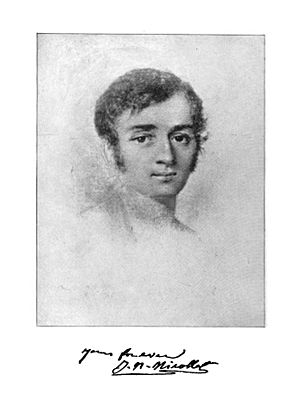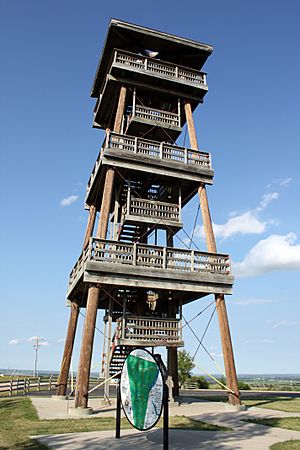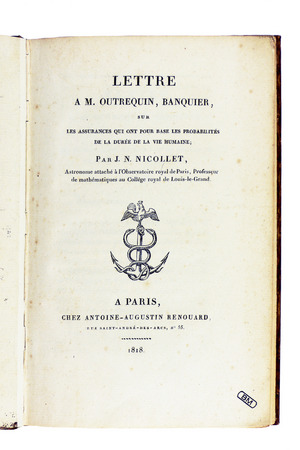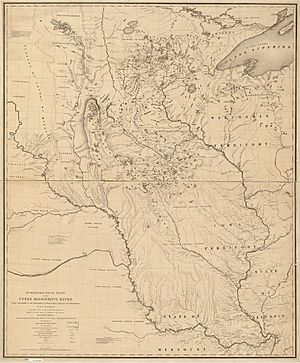Joseph Nicollet facts for kids
Quick facts for kids
Joseph Nicollet
|
|
|---|---|

Portrait and autograph of J.N. Nicollet
|
|
| Born | July 24, 1786 |
| Died | September 11, 1843 (aged 57) Washington, D.C., United States
|
| Nationality | French |
| Occupation | Explorer, mathematician |
| Known for | Cartography of the Mississippi River |
Joseph Nicolas Nicollet (born July 24, 1786 – died September 11, 1843) was a French scientist. He was a geographer, astronomer, and mathematician. He is famous for mapping the Upper Mississippi River area in the 1830s. Nicollet led three trips to explore the region. These trips were mostly in what is now Minnesota, South Dakota, and North Dakota. This area is between the Mississippi River and Missouri River.
Before coming to the United States, Nicollet taught math. He also worked as an astronomer at the Paris Observatory. He worked with a famous scientist named Pierre-Simon Laplace. Changes in France made him want to travel. He hoped to gain more fame for his work in the US. He became a member of the American Philosophical Society in 1842.
Nicollet's maps were very accurate for his time. They fixed mistakes made by earlier explorers like Zebulon Pike. His maps became the base for all future maps of the American interior. They were also some of the first to show elevation using a method called hachuring. His maps were also special because they used Native American place names. Nicollet's Map of the Hydrographical Basin of the Upper Mississippi was published in 1843, after he died. Today, Nicollet Tower in Sisseton, South Dakota is a monument to his important work. It was built in 1991.
Contents
Early Life and Education
Joseph Nicollet was born in Cluses, a town in Savoy, France. He was a very smart child. He was especially good at mathematics and astronomy. Because of his talent, he received a scholarship. This allowed him to attend a Jesuit college in Chambéry.
He started teaching mathematics when he was just 19 years old. In 1817, he became a professor and astronomer. He worked at the Paris Observatory with the famous scientist Pierre-Simon Laplace. While working there, Nicollet discovered a comet. This helped him become known as an expert in astronomy and physical geography. In the 1820s, he also taught mathematics at the Collège Louis-le-Grand.
Moving to the United States in 1832
Nicollet faced money and job problems in France. This was due to political changes after the July Revolution (1830). Also, physics was becoming more popular as a science. Because he had no money, he moved to the United States in 1832. He sailed from the port of Brest.
Nicollet hoped his work in the US would make him more famous. He wanted to do a "scientific tour" of the country. His main goal was to accurately map the Mississippi River Valley. He arrived in Washington, D.C., and met with scientists. He also talked to government officials about surveying the country.
He then traveled to New Orleans. From there, he planned to go to St. Louis, Missouri. However, a cholera outbreak stopped steamboat travel. So, he spent the next three years traveling. He explored areas between New Orleans and Baltimore. Nicollet finally reached St. Louis in 1835.
Mapping the Mississippi River
When Nicollet arrived in St. Louis in 1835, he found support for his mapping plan. The American Fur Company helped him. The wealthy Choteau family also supported him. This family had helped found St. Louis. They also had a long history in the fur trade.
From St. Louis, Nicollet took a boat up the river. He went to Fort Snelling, in Minnesota. Over the next four years, Nicollet led three expeditions. He explored the Upper Mississippi River area. Most of his explorations were in what is now Minnesota, North Dakota, and South Dakota.
First Expedition (1836–1837)
His first expedition happened in 1836–1837. It was paid for by the American Fur Company and the Choteau family. Nicollet left Fort Snelling by canoe on July 29, 1836. He was joined by Chagobay, an Ojibwe chief, and his nine-year-old son. A guide named Brunia, who was half-French, also came along.
Nicollet explored the Mississippi River all the way to its source, Lake Itasca. He also explored the nearby St. Croix River. The results of this trip fixed a mistake. Zebulon Pike's 1805 map had placed the mouth of the Crow Wing River too far west. This made all maps of that area wrong.
Second Expedition (1838)
After his first trip, Nicollet returned to Washington, D.C. He reported his findings there. He was then chosen to lead a new expedition. This trip was funded by the United States Department of War. Its goal was to map the area between the Mississippi and Missouri Rivers. This would correct the western maps that had errors from Pike's mistake.
The expedition team started on June 18, 1838. They left from Traverse des Sioux. The group included John C. Frémont. The War Department sent Frémont to help. Joseph Renville Jr. and Joseph LaFromboise also joined. LaFromboise was an agent for the American Fur Company. He was half French and half Native American.
On July 4, 1838, the team reached Pipestone Quarry. There, they carved their initials on a rock. From there, they traveled along the Minnesota and Blue Earth Rivers. Their journey continued toward Spirit Lake, Iowa.
Third Expedition
On his third and last expedition, Nicollet had help from Frémont again. Louison Freniere was their guide. The Jesuit Missionary Pierre-Jean De Smet joined them for part of the trip. De Smet used skills he learned from Nicollet. He later made his own maps of the Missouri River basin.
On this trip and the second one, a botanist named Charles Geyer took many notes. He cataloged the native plants of the area. This journey was also paid for by the government. Nicollet traveled northwest from Iowa. He went along the Missouri River toward Fort Pierre, South Dakota. His efforts faced a problem when the steamboat Pirate, carrying his supplies, sank in April 1839.
On July 11, 1839, the second part of his trip began. They left Fort Pierre for Devil's Lake, North Dakota. From there, Nicollet traveled back across the Coteau des Prairies. He returned to Fort Snelling.
Death
On September 11, 1839, Nicollet returned to Washington, D.C. He worked on putting all his collected information into a report for the Senate. He had planned to go back to Minnesota to keep working. However, his health got worse. He died in Washington in 1843. He is buried at the Congressional Cemetery. His gravestone has a special message. It says, "He will triumph who understands how to conciliate and combine with the greatest skill the benefits of the past with the demands of the future."
Legacy and Impact

Later in 1843, a book with much of his work was published. It was called Map of the Hydrographical Basin of the Upper Mississippi. The maps in this book were very accurate. They covered a huge area, more than half the size of Europe. Nicollet's maps were among the first in the world to show elevation. They used a method called hachuring. They are also some of the only sources for original Native American place names in the region.
Many of Nicollet's drawings and journals from his trips are kept safe. You can find them at the Library of Congress, the Smithsonian Institution, and the National Archives. In 1847, one of his trip sponsors, Pierre Chouteau Jr., started Fort Benton. This was the furthest fur-trading post on the Upper Missouri River. Later, Chouteau County, Montana was named in his honor.
Nicollet's own name is used for several places in the area he explored. These include Nicollet Island and Nicollet Avenue in Minneapolis. Also, Nicollet County and the city of Nicollet are named after him. All these places are in Minnesota.
In 1991, the Joseph N. Nicollet Tower and Interpretive Center was built. It is in Sisseton, South Dakota. It is near the path Nicollet took on his last trip. A banker from Sisseton became very interested in Nicollet's story. He read Joseph N. Nicollet on the Plains and Prairies. This book was a translation of Nicollet's journals. The banker then raised $335,000 from local donors. This money helped build the monument.
The tower is 80 feet tall and has 96 steps. It was mostly built from Douglas fir wood from Idaho. It also has concrete pillars and steel bolts. From the top, you can see six counties in three states. These states are South Dakota, North Dakota, and Minnesota. You can also see the Laurentian Divide and the Coteau des Prairies. You can even see the ancient glacial valley that Nicollet mapped. The Interpretive Center has 2,400 square feet of space. It has classrooms and exhibits. These include Nicollet's map and a mural. The mural shows Nicollet meeting Wanata, a chief of the Yankton Dakota.
See also
In Spanish: Jean Nicholas Nicollet para niños



